- Details
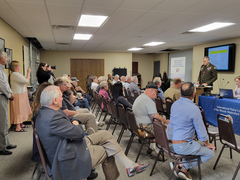 The IJC’s International Rainy-Lake of the Woods Watershed Board held its annual meetings with the public in Baudette, Minnesota on August 16 and Kenora, Ontario on August 17.
The IJC’s International Rainy-Lake of the Woods Watershed Board held its annual meetings with the public in Baudette, Minnesota on August 16 and Kenora, Ontario on August 17.
The IJC watershed board presented an update on its activities during the past year and key priorities for the coming year. The board's Aquatic Ecosystem Health Committee is leading several projects this year, including: focus on international water quality objectives and core monitoring design, studies of erosion at the south shore of Lake of the Woods, and reporting of exceedances of water quality criteria.
The board hosted guest updates from the Minnesota Pollution Control Agency and Environment and Climate Change Canada on these agencies’ work to address the phosphorus loading that feeds the excessive algae blooms on Lake of the Woods.
- Details
Until international phosphorus objectives are agreed to by governments, the IJC watershed board has adopted an interim approach of reporting on exceedances compared to the most stringent water quality criteria used by local state, provincial, or federal agencies for these shared waters.
The IJC watershed board's Aquatic Ecosystem Health Committee co-chaired by LOWWSF's Todd Sellers, is leading the IJC International Rainy-Lake of the Woods Watershed Board’s current compilation of its annual water quality exceedances report. The report draws on monitoring data provided by federal, state and provincial, and Indigenous agencies and will focus on phosphorus and related algae levels on Lake of the Woods and Rainy River, the principal water quality issues of international concern. Phosphorus is the primary nutrient feeding algae blooms and phosphorus loadings to the lake and its main tributary, the Rainy River, has been the focus of intensive studies by Minnesota and Canada.
The report will also present a summary of exceedances or spills (if any) of the permitted wastewater facilities discharging into the Rainy River and Lake of the Woods.
The report should be completed and submitted to the IJC in late fall – we’ll let you know when it is available and have a summary of findings on the Foundation website.
- Details
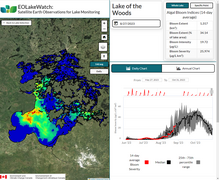 We’ve all seen the compelling satellite pictures of blue green algae blooms covering Lake of the Woods. As part of the Environment and Climate Change Canada’s Lake of the Woods Science Plan (2016-2020), Dr. Caren Binding developed a system to harness these images for near real-time tracking of algae blooms and computation of indices of bloom severity, intensity and extent across the lake. At that time, Dr. Binding launched an online tool, ECCC’s EOLakeWatch, for public access to this information. I highly recommend you check it out!
We’ve all seen the compelling satellite pictures of blue green algae blooms covering Lake of the Woods. As part of the Environment and Climate Change Canada’s Lake of the Woods Science Plan (2016-2020), Dr. Caren Binding developed a system to harness these images for near real-time tracking of algae blooms and computation of indices of bloom severity, intensity and extent across the lake. At that time, Dr. Binding launched an online tool, ECCC’s EOLakeWatch, for public access to this information. I highly recommend you check it out!
Coming soon is a “version 2.0” of the EOLakeWatch interactive visualization and data portal for the satellite image processing system. I’ve had an opportunity to view the beta version and am very impressed. It provides ability for the public to display and download maps, charts and data on bloom indices that can be customized to visually show daily values, 14-day averages, and current year blooms compared to the historical values from 2002 and on.
- Details
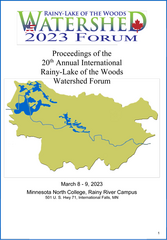 The Proceedings Report of the 2023 International Rainy-Lake of the Woods Watershed Forum is available for download at the Foundation’s website: lowwsf.com/forum-proceedings. Held March 8-9 in International Falls Minnesota, 132 researchers, resource managers, policy makers, and members of the public put Lake of the Woods and its watershed under the microscope.
The Proceedings Report of the 2023 International Rainy-Lake of the Woods Watershed Forum is available for download at the Foundation’s website: lowwsf.com/forum-proceedings. Held March 8-9 in International Falls Minnesota, 132 researchers, resource managers, policy makers, and members of the public put Lake of the Woods and its watershed under the microscope.
The report covers a wide range of subjects – Many of the 25 presentations this year focused on knowledge and tools that will inform management actions. The schedule was full, with research presentations split among six sessions covering a wide range of disciplines including: water quality management and monitoring, watershed management, nutrients and algal blooms and toxins, and emergent technologies for remote sensing and monitoring.
Please
pdf
download a copy of the report now.(9.19 MB)
- Details
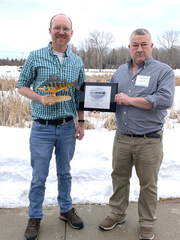 Mike Hirst, Resource Conservationist with the Lake of the Woods Soil and Water Conservation District is the 2023 recipient of the Kallemeyn Award, recognizing his outstanding professional achievements and contributions to collaborative research and resource management in the Rainy-Lake of the Woods Basin.
Mike Hirst, Resource Conservationist with the Lake of the Woods Soil and Water Conservation District is the 2023 recipient of the Kallemeyn Award, recognizing his outstanding professional achievements and contributions to collaborative research and resource management in the Rainy-Lake of the Woods Basin.
The Kallemeyn Award was presented to Mike by the Lake of the Woods Water Sustainability Foundation on behalf of the community of scientists and resource managers from the United States and Canada attending the 2023 International Rainy-Lake of the Woods Watershed Forum in International Falls, MN.
- Details
To honour the memory of Deborah Battigelli, her family established The Deborah Battigelli Memorial Fund at the Lake of the Woods Water Sustainability Foundation. This Fund honours Deborah’s love of life at the lake and her interest to preserve the lake area for future generations to continue to enjoy what she loved. The Fund assists the up-and-coming generation of scientists with their research on our lakes with limited travel support to present their research at the Rainy-Lake of the Woods Watershed Forum. We are pleased to announce that two deserving graduate students will received Deborah Battigelli Memorial Fund awards to present at the Forum in 2023.
- Details
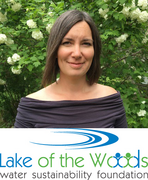 The Lake of the Woods Water Sustainability Foundation is pleased to introduce Teika Newton as the new International Watershed Coordinator.
The Lake of the Woods Water Sustainability Foundation is pleased to introduce Teika Newton as the new International Watershed Coordinator.
Teika is a long-time participant in regional watershed science, policy, and governance activities. She has served as a board member for the International Joint Commission’s International Rainy–Lake of the Woods Watershed Board, and co-chaired the Board’s Community Advisory Group, Engagement Committee, and currently the Adaptive Management Committee. Teika also has been helping to guide the IJC Board’s work on climate adaptation since 2016.
With Teika joining our team, the Foundation is doubling down to move projects forward that are central to a sustainability plan, including defining recommendations for international water quality objectives and a multi-nationally coordinated monitoring program, in collaboration with the IJC, Nations, and agencies in the basin.
- Details
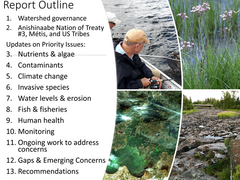 The Lake of the Woods Water Sustainability Foundation is pleased to announce the release of the 2022 Rainy-Lake of the Woods State of the Basin Report (SOBR) lowwsf.com/sobr.
The Lake of the Woods Water Sustainability Foundation is pleased to announce the release of the 2022 Rainy-Lake of the Woods State of the Basin Report (SOBR) lowwsf.com/sobr.
The report outlines changes that have occurred since the last report in 2014, focusing on the primary areas of concern in the watershed of nutrients and algae, contaminants, climate change, aquatic invasive species, and erosion/water levels. The report also highlights concerns about the health of the walleye fishery in the north end of Lake of the Woods and includes a new chapter on human health concerns in the watershed.
The 2022 SOBR is available in two versions: a detailed technical report of 148 pages, and an overview report of 32 pages, highlighting key findings and written for a general audience. We encourage you to read the overview version and to explore additional details in the full 148-page version, both of which are available for download at the Foundation’s website, lowwsf.com/sobr.
